Synergistic Use of Hypocotyl Explants and High Bap Preconditioning for Enhanced Transformation Frequency in Brinjal (Solanum melongena L.)
DOI:
https://doi.org/10.24154/jhs.v1i2.650Keywords:
Solanum melongena, Transformation, Hypocotyl, BAP, PreconditioningAbstract
Poor regeneration is one of the limiting factors in the development of transgenic crops since Agrobacterium as a plant pathogen can disturb the fragile in vitro conditions with wounding and infection regimes. We have tried to optimize the transformation system in two important varieties of brinjal after Agrobacterium infection to the explants. The effect of explant was studied and hypocotyls were found to be better than cotyledonary leaves. High BAP during the preconditioning period was found to further enhance the regeneration rate. Therefore, use of hypocotyls and high BAP during preconditioning can improve the regeneration of transformed cells and recovery of transformants in vegetables especially brinjal.
Downloads
References
Allichio, R., Del Grosso, E . and Boschieri, E. 1982. Tissue cultures and plant regeneration from different explants in six cultivars of Solanum melongena. Experientia, 38: 449-450. DOI: https://doi.org/10.1007/BF01952632
Billings, S., Jelenkovic, G., Chin, C. K. and Eberhardt, J.1997. The effect of growth regulation and antibiotics on eggplant transformation. J. Amer. Soc. Hort. Sci.,122:158-162. DOI: https://doi.org/10.21273/JASHS.122.2.158
Collonnier, C., Fock, I., Kashyap, V., Rotino, G. L., Daunay,M. C., Lian, Y., Mariska, I. K., Rajam, M. V., Servaes,A., Ducreux, G. and Sihachakr, D. 2001, Applications of biotechnology in eggplant. Plant Cell Tissue OrganCult.,5: 91-107. DOI: https://doi.org/10.1023/A:1010674425536
Ditt, R. F., Nester, E. W. and Comai, L. 2001. Plant gene expression response to Agrobacterium tumefaciens. Proc. Natl. Acad. Sci.,USA, 98: 10954-10959. DOI: https://doi.org/10.1073/pnas.191383498
Freitas, V. G., Lacorte, C., Sachetto-Martins, G., Krul, W.R., Oliveira, D. E., Neves, L. J. and Mansur, E. 1997. Identification of competent cells for Agrobacterium-transformation and in vitro regeneration in peanut leaf and cotyledon explants. R. Bras. Fisiol. Veg.,9:157-167.
Gelvin, S. B. 2000. Agrobacterium and plant genes involved in T-DNA transfer and integration. Annu. Rev. Plant.Physiol. Plant. Mol. Biol.,51: 223-256. DOI: https://doi.org/10.1146/annurev.arplant.51.1.223
Hamza, S. and Chupeau, Y. 1993. Re-evaluation of conditions for plant regeneration and Agrobacterium-mediated transformation from tomato. J. Exp. Bot.,44: 1837-1845. DOI: https://doi.org/10.1093/jxb/44.12.1837
Hanur, V. S. 2004. Genetic transformation of human cells by a soil phytopathogen presents common molecular strategies. Curr. Sci.,87: 856-857.
Kumar, P. A., Mandaokar, A. D. and Sharma, R. P. 1998a.Genetic engineering for the improvement of eggplant (Solanummelongena L.). Ag Biotech News Inform.,10: 329-332.
Kumar, P. A., Mandaokar, A., Sreenivasu, K., Chakrabarti,S. K., Bisaria, S., Sharma, S. R., Kaur, S. and Sharma,R. P. 1998b. Insect-resistant transgenic brinjal plants.Mol. Breed.,4: 33-37. DOI: https://doi.org/10.1023/A:1009694016179
Kumar, S. V. and Rajam, M. V. 2005. Enhanced induction of vir genes results in the improvement of Agrobacte-rium-mediated transformation of eggplant. J. Plant Biochem. Biotechnol.,14: 89-94. DOI: https://doi.org/10.1007/BF03263234
Lin, J. J., Assad-Garcia, N. and Kuo, J. 1994. Improved regeneration of plant tissues: a novel medium format and membrane based liquid culture system. Focus,16:72.
Lipp-Joao, K. H. and Brown, T. A. 1993. Enhanced transformation of tomato co-cultivated with Agrobacterium tumefaciens C58C1 Rifr::pGSFR1161 in the presence of acetosyringone. Pl. Cell Rep.,12:422-425. DOI: https://doi.org/10.1007/BF00234705
Magioli, C. and Mansur, E. 2005. Eggplant (Solanummelongena L.): tissue culture, genetic transformation and use as an alternative model plant. Acta Bot. Bras.,19: 139-148. DOI: https://doi.org/10.1590/S0102-33062005000100013
Magioli, C., Rocha, A. P. M., de Oliveira, D. E. and Mansur,E. 1998. Efficient shoot organogenesis of eggplant (Solanummelongena L.) induced by thidiazuron. Pl.Cell Rep.,17: 661-663. DOI: https://doi.org/10.1007/s002990050461
Mc-Hughen, A., Jordan, M. and Feist, G. 1989. A precultureperiod prior to Agrobacterium inoculation increases production of transgenic plants. J. Plant Physiol.,135: 245-248. DOI: https://doi.org/10.1016/S0176-1617(89)80187-7
Murashige, T. and Skoog, F. 1962. A revised method for rapid growth and bioassays with tissue cultures.Physio.l Plant.,15: 473-497. DOI: https://doi.org/10.1111/j.1399-3054.1962.tb08052.x
Robinette, D. and Matthysse, A. G. 1990. Inhibition by Agrobacterium tumefaciens and Pseudomonas savastanoi of development of the hyper sensitive response elicited by Pseudomonas syringae pv.phaseolicola. J. Bacteriol.,172: 5742-5749. DOI: https://doi.org/10.1128/jb.172.10.5742-5749.1990
Rotino, G. L. and Gleddie, S. 1990. Transformation of eggplant (Solanum melongena L.) using a binary Agrobacterium tumefaciens vectors. Plant Cell Rep.,9: 26-29. DOI: https://doi.org/10.1007/BF00232129
Sharma, P. and Rajam, M. V. 1995. Genotype, explant and position effects on organogenesis and embryogenesis in eggplant (Solanum melongena L.). J. Exp. Bot,,46: 135-141. DOI: https://doi.org/10.1093/jxb/46.1.135
Downloads
Published
Issue
Section
License
Copyright (c) 2006 Vageeshbabu S Hanur, D P Prakash, B S Deepali, R Asokan, Y L Ramachandra, Riaz Mahmood, Lalitha Anand (Author)

This work is licensed under a Creative Commons Attribution-NonCommercial-ShareAlike 4.0 International License.
Authors retain copyright. Articles published are made available as open access articles, distributed under the terms of the Creative Commons Attribution-NonCommercial-ShareAlike 4.0 International License, which permits unrestricted non-commercial use, distribution, and reproduction in any medium, provided the original author and source are credited. 
This journal permits and encourages authors to share their submitted versions (preprints), accepted versions (postprints) and/or published versions (publisher versions) freely under the CC BY-NC-SA 4.0 license while providing bibliographic details that credit, if applicable.





 .
. 











